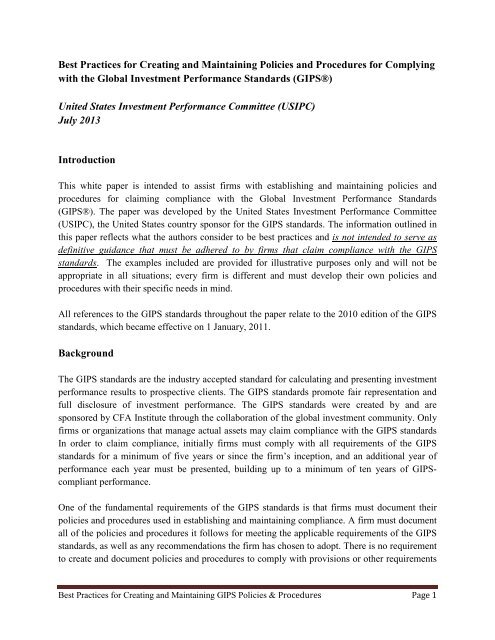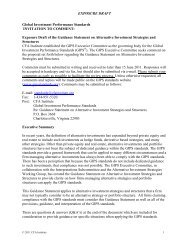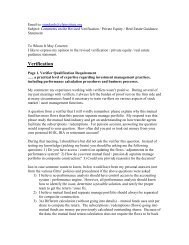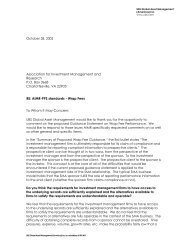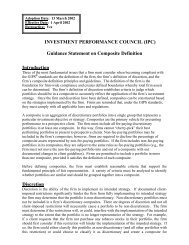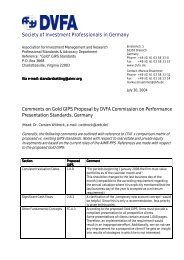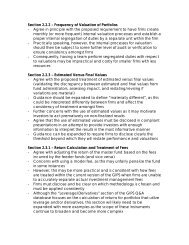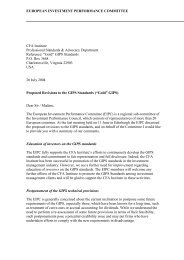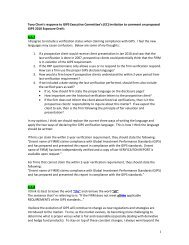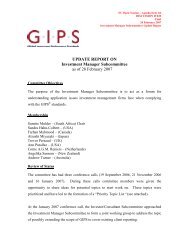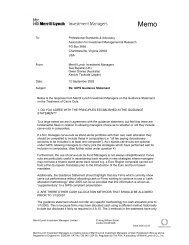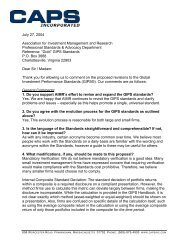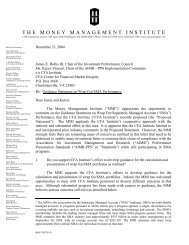Best Practices for Creating and Maintaining Policies and ... - GIPS
Best Practices for Creating and Maintaining Policies and ... - GIPS
Best Practices for Creating and Maintaining Policies and ... - GIPS
You also want an ePaper? Increase the reach of your titles
YUMPU automatically turns print PDFs into web optimized ePapers that Google loves.
e included in at least one composite. Although non-fee-paying discretionary portfolios may beincluded in a composite, non-discretionary portfolios must not be included in composites.Composites must include all portfolios within the firm definition that meet the compositedefinition.Composite definitions (the detailed criteria that determine the assignment of portfolios tocomposites) must be documented in the firm’s policies <strong>and</strong> procedures. Composite descriptions(the general in<strong>for</strong>mation regarding the investment m<strong>and</strong>ate, objective, or strategy of thecomposite) must be disclosed in compliant presentations. Composite descriptions may be moreabbreviated than composite definitions, but still must include all key features of the composite<strong>and</strong> must include enough in<strong>for</strong>mation to allow a prospective client to underst<strong>and</strong> the keycharacteristics of the composite’s investment m<strong>and</strong>ate, objective, or strategy.Firms must provide a complete list of composite descriptions to any prospective client thatmakes such a request. Terminated composites must be included on the list <strong>for</strong> at least five yearsafter the composite termination date.Refer to Appendix C of the 2010 edition of the <strong>GIPS</strong> st<strong>and</strong>ards <strong>for</strong> a sample list of compositedescriptions.Example policy:All actual, fee-paying, discretionary portfolios are included in at least one composite. Nondiscretionaryportfolios, as well as non-fee-paying portfolios, are not included in composites.Composites include only actual assets managed by the firm. Simulated or back-testedportfolios are not included in composites or linked with actual per<strong>for</strong>mance returns.Composites are defined according to investment m<strong>and</strong>ate, objective or strategy. Compositesinclude all discretionary, fee-paying portfolios that meet the composite definition.A list of detailed composite definitions is included within these policies <strong>and</strong> procedures asAppendix A. The firm also maintains a complete list of composite descriptions, including allcomposites that have closed within the past five years. The firm’s list of compositedescriptions is provided to any client or prospective client who requests it.Procedures to consider:• Portfolio managers <strong>and</strong> marketing departments should be consulted to appropriatelydefine composites by investment m<strong>and</strong>ate, objective, or strategy. Since the investmentobjectives documented in investment management agreements will be utilized to supportthe inclusion of portfolios in composites, these should also be consistent with the firm’sdefinition of the strategy.<strong>Best</strong> <strong>Practices</strong> <strong>for</strong> <strong>Creating</strong> <strong>and</strong> <strong>Maintaining</strong> <strong>GIPS</strong> <strong>Policies</strong> & Procedures Page 9
• The firm should document procedures <strong>for</strong> maintaining the list of composite descriptions,as well as the process <strong>for</strong> responding to requests <strong>for</strong> copies of the list. Note that firmsmust include terminated composites on the firm’s list of composite descriptions <strong>for</strong> atleast five years after the composite termination date.Helpful hints:• Composite definitions should identify key characteristics, including risks specific to thecomposite, minimum portfolio size (if any), <strong>and</strong> benchmarks.• Take care in setting composite definitions. Too broad a definition may cause unwanteddispersion, while too narrow a definition may cause portfolios to be excluded eventhough they are not materially different from others included in the composite. Note thatcomposite definitions also correlate to composite assets under management; a broaddefinition captures larger amounts of assets than a more narrow definition.V. Composite constructionComposites must include new portfolios on a timely <strong>and</strong> consistent basis after each portfoliocomes under management. Terminated portfolios must be included in the historical per<strong>for</strong>manceof the composite up to the last full measurement period that each portfolio was undermanagement. Portfolios must not be switched from one composite to another unless documentedchanges to a portfolio’s investment m<strong>and</strong>ate, objective, or strategy or the redefinition of thecomposite makes it appropriate. The historical per<strong>for</strong>mance of portfolios that terminate or switchcomposites must remain with the original composite.Firms may establish minimum asset levels <strong>for</strong> portfolios to be included in composites. Thepurpose of a minimum asset level should be to exclude portfolios from the composite that are toosmall to be representative of the intended strategy. If the firm sets a minimum asset level <strong>for</strong>portfolios to be included in a composite, the firm must not include portfolios below the minimumasset level in that composite. Minimums can vary by composite.Firms that wish to remove portfolios from composites in cases of significant cash flows mustdefine “significant” on an ex-ante, composite-specific basis <strong>and</strong> must consistently follow thecomposite-specific policy. The <strong>GIPS</strong> st<strong>and</strong>ards define a significant cash flow as the level atwhich the firm determines that a client-directed external cash flow may temporarily prevent thefirm from implementing the composite strategy, thereby causing the portfolio to no longer berepresentative of the composite strategy. Portfolios that experience a significant cash flow aretemporarily removed from the composite. Firms may also seek to minimize the impact ofsignificant cash flows through the use of temporary new accounts.<strong>Best</strong> <strong>Practices</strong> <strong>for</strong> <strong>Creating</strong> <strong>and</strong> <strong>Maintaining</strong> <strong>GIPS</strong> <strong>Policies</strong> & Procedures Page 10
Example policy:Composites include new portfolios at the beginning of the first full month under management.Terminated portfolios are included in the historical per<strong>for</strong>mance of appropriate compositesthrough the last full month under management. Portfolios that switch composites due tostrategy changes are removed from composites at the end of the last month under the oldm<strong>and</strong>ate <strong>and</strong> are eligible <strong>for</strong> re-inclusion in composites at the beginning of the first fullmonth after the change.Some (but not all) of the firm’s composites have established minimum asset levels <strong>for</strong>portfolios to be included or policies <strong>for</strong> temporarily removing portfolios that experiencesignificant cash flows. These minimum asset levels <strong>and</strong> significant cash flow policies areoutlined in the firm’s composite definitions, outlined in Appendix A.Procedures to consider:• Firms should establish procedures to ensure that all fee-paying discretionary portfoliosare assigned to the appropriate composites. This should include periodic evaluations ofthe full list of portfolios within the scope of the firm definition, validating thediscretionary status <strong>and</strong> composite assignment (if applicable) <strong>for</strong> each portfolio, <strong>and</strong>reconciling between the portfolios in composites <strong>and</strong> total firm assets.• Firms should monitor new <strong>and</strong> terminated portfolios, as well as strategy changes. Firmsshould have procedures to be notified of these events <strong>and</strong> could build exception reports totrack these items. Procedures should also address the necessary communication of clientdirected portfolio changes from those responsible <strong>for</strong> interacting directly with clients tothose responsible <strong>for</strong> maintaining composites.• Composite dispersion should be monitored <strong>and</strong> an outlier analysis could be per<strong>for</strong>med toanalyze the appropriateness of the inclusion of portfolios in each composite.• Firms should establish procedures <strong>for</strong> reviewing portfolios that may fall below prescribedminimum asset levels or experience significant cash flows <strong>and</strong> removing such portfoliosfrom composites on a consistent basis.Helpful hints:• Firms should consider a grace period policy prior to including portfolios in compositesbased on when a portfolio manager can fully implement the intended investmentm<strong>and</strong>ate, objective or strategy. The grace period may vary by composite.• If there is an unusual delay be<strong>for</strong>e including a new portfolio in a composite, it is goodpractice to document the reasons <strong>for</strong> the delay.• Closed portfolios should be excluded from composites based on the date the firm wasinstructed to change the implementation of the portfolio’s strategy such that it was no<strong>Best</strong> <strong>Practices</strong> <strong>for</strong> <strong>Creating</strong> <strong>and</strong> <strong>Maintaining</strong> <strong>GIPS</strong> <strong>Policies</strong> & Procedures Page 11
For periods prior to January 1, 2011, the <strong>GIPS</strong> st<strong>and</strong>ards require the use of market value, whichis defined as the current price at which investors buy or sell securities at a given time, in order tobest identify the fair economic value of the firm’s portfolios.For periods beginning on or after January, 1 2011, firms must disclose the use of subjectiveunobservable inputs if they are material to the composite.Trade date accounting (rather than settlement date) must be used <strong>for</strong> all periods after January 1,2005. Accrual accounting must be used <strong>for</strong> fixed-income securities <strong>and</strong> all other investments thatearn interest income. Accrual accounting should be used <strong>for</strong> dividends (as of the ex-dividenddate).Refer to the <strong>GIPS</strong> Valuation Principles in Chapter II of the 2010 edition of the <strong>GIPS</strong> st<strong>and</strong>ards<strong>for</strong> additional in<strong>for</strong>mation.Example policy:Valuations are generally obtained from qualified independent third-parties in accordancewith the firm’s valuation hierarchy. The firm’s valuations hierarchy does not materiallydiffer from the recommended hierarchy in the <strong>GIPS</strong> Valuation Principles. The firm generallyonly invests in securities that are traded in active markets, valuation inputs are objective,<strong>and</strong> where market prices <strong>for</strong> identical securities are readily available. However, if theaggregation of portfolio investments valued using subjective unobservable inputs in acomposite strategy is greater than 10%, the use of these inputs will be disclosed in thecompliant presentation.Valuation Hierarchy:a. Investments must be valued using objective, observable, unadjusted quoted marketprices <strong>for</strong> identical investments in active markets on the measurement date, ifavailable. If not available, then investments should be valued using;b. Objective, observable quoted market prices <strong>for</strong> similar investments in active markets.If not available or appropriate, then investments should be valued using;c. Quoted prices <strong>for</strong> identical or similar investments in markets that are not active(markets in which there are few transactions <strong>for</strong> the investment, the prices are notcurrent, or price quotations vary substantially over time <strong>and</strong>/or between marketmakers). If not available or appropriate, then investments should be valued based on;d. Market-based inputs, other than quoted prices, that are observable <strong>for</strong> the investment.If not available or appropriate, then investments should be valued based on;<strong>Best</strong> <strong>Practices</strong> <strong>for</strong> <strong>Creating</strong> <strong>and</strong> <strong>Maintaining</strong> <strong>GIPS</strong> <strong>Policies</strong> & Procedures Page 13
e. Subjective unobservable inputs <strong>for</strong> the investment where markets are not active at themeasurement date. Unobservable inputs should only be used to measure fair value tothe extent that observable inputs <strong>and</strong> prices are not available or appropriate.Trade date accounting is used <strong>for</strong> all periods. Accrual accounting is used <strong>for</strong> fixed incomesecurities <strong>and</strong> all other investments that earn interest income. Accrued income is included inbeginning <strong>and</strong> ending portfolio market values when calculating per<strong>for</strong>mance. Dividends areaccrued as of the ex-dividend date.Procedures to consider:• The firm may choose to establish a valuation policy documented outside of the firm’s<strong>GIPS</strong> policies <strong>and</strong> procedures. Such a policy could detail valuation procedures <strong>for</strong>specific asset classes or securities.• Firms should consider having a valuation oversight committee to ensure that valuations ofportfolio investments have integrity <strong>and</strong> fairly reflect their value.• When the firm regularly receives or calculates multiple valuations <strong>for</strong> one portfolio (e.g.,internal valuations compared to those received from the custodian or a fundadministrator), the firm should determine which will be the official valuation source <strong>for</strong>that portfolio <strong>and</strong> use that source consistently.• Firms should establish a regular review of the use of subjective, unobservable inputs todetermine if these investments are material to each of their composite strategies.• Firms’ accruals should be verified through timely reconciliations between the firm’srecords <strong>and</strong> the custodian’s records.Helpful hints:• Firms that typically invest only in liquid securities in active markets should still consideraddressing in their policies <strong>and</strong> procedures potential scenarios where markets suddenlybecome illiquid <strong>and</strong> objective, observable investment prices are unavailable.VII. Portfolio valuation frequencyThe <strong>GIPS</strong> st<strong>and</strong>ards have gradually increased the minimum required frequency of portfoliovaluation from quarterly (prior to 2001), to monthly (from the beginning of 2001 to the end of2009), then to as of each calendar month end or the last business day of the month as well as onthe date of all large cash flows (beginning in 2010). A large cash flow, which is to be defined bythe firm <strong>for</strong> each composite, is the level at which the firm determines that an external cash flow(cash or investments that enter or exit a portfolio) may distort per<strong>for</strong>mance if the portfolio is notvalued at the time of the cash flow. Firms must define the amount in terms of the value of thecash/asset flow or in terms of a percentage of portfolio assets or the composite assets. Firms mustalso determine if a large cash flow is a single external cash flow or an aggregate of a number ofexternal cash flows within a stated period of time.<strong>Best</strong> <strong>Practices</strong> <strong>for</strong> <strong>Creating</strong> <strong>and</strong> <strong>Maintaining</strong> <strong>GIPS</strong> <strong>Policies</strong> & Procedures Page 14
Example policy:Portfolios are valued on the last business day of each month <strong>and</strong> on the date of all largeexternal cash flows. The firm has defined a “large” cash flow as a single external cash flow(contribution or withdrawal of cash or investments) equal to or greater than 5% of thebeginning-of-month value of the portfolio. The definition of large cash flow has been appliedconsistently across all composites.Procedures to consider:• Some firms may have difficulty obtaining accurate valuations more frequently thanmonthly. Since firms are required to revalue portfolios on the date of all large externalcash flows as of January 1, 2010, the firm’s procedures related to the frequency ofportfolio valuation should address how <strong>and</strong> from where the firm will obtain intra-monthvaluations when necessary.• If not automated, firms should describe how large cash flows are identified.Helpful hints:• The firm may establish valuation policies that differ on a composite-by-composite basis.Depending on the nature of the firm’s business, having different valuation policies <strong>for</strong>different composites or account types may not be practical.• The firm’s composite-specific valuation policy may also differentiate between accounttypes within the composite. For example, if a composite contains mutual funds <strong>and</strong>separate accounts, the firm’s policy may be to value the mutual funds daily while theseparate accounts are only priced at month-end <strong>and</strong> on the date of all large cash flows.• The firm must follow the composite-specific valuation policy consistently. If a portfolioincurs an external cash flow that is less than the defined large cash flow threshold, thenthe firm must not value the portfolio <strong>for</strong> return calculation purposes.VIII. Portfolio per<strong>for</strong>mance calculationsThe <strong>GIPS</strong> st<strong>and</strong>ards m<strong>and</strong>ate the use of certain calculation methodologies to facilitatecomparability. Firms must calculate time-weighted rates of return that adjust <strong>for</strong> external cashflows. Total returns including both realized <strong>and</strong> unrealized gains <strong>and</strong> losses must be used <strong>and</strong>returns from cash <strong>and</strong> cash equivalents held in portfolios must be included in all returncalculations. In addition, all returns must be calculated after the deduction of the actual tradingexpenses incurred during the period. Returns should be calculated net of non-reclaimablewithholding taxes on dividends, interest, <strong>and</strong> capital gains. Reclaimable withholding taxes shouldbe accrued.<strong>Best</strong> <strong>Practices</strong> <strong>for</strong> <strong>Creating</strong> <strong>and</strong> <strong>Maintaining</strong> <strong>GIPS</strong> <strong>Policies</strong> & Procedures Page 15
Example policy:All per<strong>for</strong>mance results are total returns, including both realized <strong>and</strong> unrealized gains <strong>and</strong>losses plus income. Portfolio per<strong>for</strong>mance results are calculated on a monthly basis using theModified Dietz method. Sub-period calculations are per<strong>for</strong>med during periods where largecash flows occur. Sub-period returns are geometrically linked to arrive at monthly,quarterly, <strong>and</strong> annual returns. Cash flows are assumed to occur at the beginning of the day.Returns <strong>for</strong> cash <strong>and</strong> cash equivalents held in portfolios are included in all returncalculations. All returns are calculated after the deduction of actual trading expensesincurred during the period. When applicable, per<strong>for</strong>mance is calculated net of nonreclaimablewithholding taxes on income <strong>and</strong> capital gains.Procedures to consider:• The firm’s procedures related to portfolio return calculations should address the systemsused <strong>and</strong> whether the calculations are per<strong>for</strong>med internally or by an outside vendor. Notethat even if the firm has outsourced portfolio calculations, the firm is still responsible <strong>for</strong>the accuracy of the calculations <strong>and</strong> <strong>for</strong> ensuring adherence to the <strong>GIPS</strong> st<strong>and</strong>ards. If athird-party is engaged to per<strong>for</strong>m portfolio-level per<strong>for</strong>mance calculations, it is importantto review a sample of portfolios on a regular basis to verify the calculations.• Firms should consider establishing procedures to periodically compare portfolioper<strong>for</strong>mance to composite per<strong>for</strong>mance to assist in identifying outliers that could indicatevaluation, cash flow, or calculation issues.Helpful hints:• It may be helpful to include <strong>for</strong>mulas <strong>and</strong> definitions in the firm’s policies to explain themethodologies used, including indicating if any details have changed over time.• The firm’s policies should indicate how cash flows are treated (e.g., accounted <strong>for</strong> as ofthe beginning or end of day) <strong>and</strong> that a consistent methodology is applied.• <strong>Policies</strong> <strong>for</strong> converting returns into different currencies should also be outlined, ifapplicable.IX. Composite per<strong>for</strong>mance calculationsThe composite return is the asset-weighted average of the per<strong>for</strong>mance of all portfolios in thecomposite. Firms must document the methodologies used <strong>and</strong> the frequency <strong>for</strong> asset-weightingportfolio returns when calculating composite returns. Similar to the portfolio valuationrequirements, the <strong>GIPS</strong> st<strong>and</strong>ards have gradually increased the minimum required frequency <strong>for</strong>asset-weighting portfolio returns in order to calculate composite results. Quarterly composite<strong>Best</strong> <strong>Practices</strong> <strong>for</strong> <strong>Creating</strong> <strong>and</strong> <strong>Maintaining</strong> <strong>GIPS</strong> <strong>Policies</strong> & Procedures Page 16
calculations are permitted <strong>for</strong> periods prior to January 1, 2010; subsequently, composite returnsmust be calculated at least monthly.Example policy:Composite returns are calculated on a monthly basis by asset-weighting portfolio returnsusing beginning of month valuations. Consistent beginning <strong>and</strong> ending valuation dates areused <strong>for</strong> all periods. Monthly composite per<strong>for</strong>mance results are geometrically linked toobtain quarterly <strong>and</strong> annual results.Procedures to consider:• The firm’s procedures related to composite per<strong>for</strong>mance calculations should address thesystems used, weighting methods (i.e., using beginning-of-period values or a method thatreflects both beginning-of-period values <strong>and</strong> external cash flows), <strong>and</strong> the frequency <strong>for</strong>which calculations are per<strong>for</strong>med.Helpful hints:• Firms should underst<strong>and</strong> <strong>and</strong> test the methodologies used to calculate compositeper<strong>for</strong>mance, particularly if third-party systems or vendors are being utilized.• It may be helpful to include <strong>for</strong>mulas <strong>and</strong> definitions to explain the methodologies used,including indicating if any details have changed over time.X. Treatment of feesA fee-paying portfolio incurs investment management fees, which are fees paid to the firm <strong>for</strong>the management of the portfolio. These investment management fees are typically asset based (apercentage of assets), per<strong>for</strong>mance based (based on the per<strong>for</strong>mance of the portfolio on anabsolute basis or relative to a benchmark), or a combination of the two, but may take different<strong>for</strong>ms as well.The firm’s policies <strong>and</strong> procedures should describe the methods used to calculate gross-of-fees<strong>and</strong> net-of-fees per<strong>for</strong>mance results. The <strong>GIPS</strong> st<strong>and</strong>ards define gross-of-fees per<strong>for</strong>mance as thereturn on investments reduced by any trading expenses incurred during the period. Net-of-feesper<strong>for</strong>mance is defined as the gross-of-fees return reduced by investment management fees(including per<strong>for</strong>mance-based fees <strong>and</strong> carried interest). The <strong>GIPS</strong> st<strong>and</strong>ards recommendpresenting gross-of-fees returns. If net-of-fees returns are presented, investment managementfees should be accrued.Refer to the Guidance Statement on Fees <strong>for</strong> additional in<strong>for</strong>mation.<strong>Best</strong> <strong>Practices</strong> <strong>for</strong> <strong>Creating</strong> <strong>and</strong> <strong>Maintaining</strong> <strong>GIPS</strong> <strong>Policies</strong> & Procedures Page 17
Example policy:Gross-of-fees composite per<strong>for</strong>mance figures do not reflect the deduction of investmentadvisory fees but have been reduced by all transaction costs. Net-of-fees compositeper<strong>for</strong>mance figures typically reflect the deduction of actual investment advisory fees(including per<strong>for</strong>mance based fees), transaction costs, <strong>and</strong>, in certain instances, otherexpenses, which may include custodial <strong>and</strong> administrative fees. Investment management feesare accrued on a monthly basis.In some instances, model fees are applied at the composite level to calculate net-of-feesresults. When model fees are applied, the highest investment management fee incurred byportfolios in the composite is deducted from the monthly gross-of-fees composite return tocalculate a net-of-fees return.Procedures to consider:• The firm should specify systems <strong>and</strong> <strong>for</strong>mulas used in their policies <strong>and</strong> procedures.• If actual fees are used, the firm should outline a process <strong>for</strong> validating that fees areaccurately recorded.• If model fees are used, the firm should detail how it confirms that the resulting net-offeesreturns are no higher than those that would have been calculated if actual fees hadbeen used.• Procedures should address the calculation of per<strong>for</strong>mance-based fees, if any.Helpful hints:• The treatment of fees is one area in particular where firms should consider the impact oflocal laws <strong>and</strong> regulations in addition to the <strong>GIPS</strong> st<strong>and</strong>ards. The firm should alsoconsider the expectations of prospective clients <strong>and</strong> consultants in determining whetheror not gross-of-fees or net-of-fees returns will be distributed. Regardless of which returna firm chooses to present, the firm should consider having both gross-of-fees <strong>and</strong> net-offeesreturns readily available as prospects may ask <strong>for</strong> either.• Some account-holders choose to pay a fee based on a percentage of assets in lieu of pershare commissions. Firms with these types of clients should be sure to include thesetrading costs in their calculation of gross-of-fees results.• If model fees are used, firms should address how changes to a fee schedule are h<strong>and</strong>led.<strong>Best</strong> <strong>Practices</strong> <strong>for</strong> <strong>Creating</strong> <strong>and</strong> <strong>Maintaining</strong> <strong>GIPS</strong> <strong>Policies</strong> & Procedures Page 18
XI. Developing Compliant PresentationsA compliant presentation is defined as a presentation <strong>for</strong> a composite that contains all thein<strong>for</strong>mation required by the <strong>GIPS</strong> st<strong>and</strong>ards <strong>and</strong> may also include additional in<strong>for</strong>mation <strong>and</strong>supplemental in<strong>for</strong>mation.The following must be included in a compliant presentation (not a comprehensive list):• At least five years of <strong>GIPS</strong> compliant per<strong>for</strong>mance (or since the firm’s or composite’sinception date). After five years, the firm must present an additional year of per<strong>for</strong>manceeach year, building up to a minimum of 10 years of <strong>GIPS</strong> compliant per<strong>for</strong>mance.• Annual composite returns that are clearly identified as gross-of-fees or net-of-fees.• Annual benchmark returns that reflect the investment m<strong>and</strong>ate, objective, or strategy ofthe composite.• Number of portfolios as of each annual period end unless the composite contains 5 orfewer portfolios.• Composite assets as of each annual period end.• Either total firm assets or composite assets as a percentage of total firm assets as of eachannual period end.• A measure of internal dispersion of individual portfolio returns <strong>for</strong> each annual periodunless the composite contains five or fewer portfolios <strong>for</strong> the full year.• For periods ending on or after January 1, 2011, the three-year annualized ex-postst<strong>and</strong>ard deviation (using monthly returns) of both the composite <strong>and</strong> the benchmark asof each annual period end. An additional ex-post risk measure must be shown if st<strong>and</strong>arddeviation is not relevant or appropriate <strong>for</strong> the strategy.• All applicable required disclosures.For examples of compliant presentations, refer to the samples included in Appendix A of the2010 edition of the <strong>GIPS</strong> st<strong>and</strong>ards.Example policy:Annual gross-of-fees <strong>and</strong> net-of-fees composite returns since inception are included ineach compliant presentation. Initial periods shorter than a year are also presented, whenapplicable. The number of portfolios, composite assets, <strong>and</strong> total firm assets arepresented as of each annual period end. The asset-weighted st<strong>and</strong>ard deviation ofportfolio returns is presented as a measure of internal dispersion.At least one benchmark that reflects the strategy is presented on each composite, but asecond or third benchmark may also be presented if deemed appropriate. If the firm<strong>Best</strong> <strong>Practices</strong> <strong>for</strong> <strong>Creating</strong> <strong>and</strong> <strong>Maintaining</strong> <strong>GIPS</strong> <strong>Policies</strong> & Procedures Page 19
elieves that no appropriate benchmark exists, no benchmark will be presented <strong>and</strong> thereason will be disclosed in the compliant presentation.All applicable, required disclosures are included in each compliant presentation <strong>and</strong>reviewed annually <strong>for</strong> changes or updates.Procedures to consider:• Firms should establish procedures <strong>for</strong> updating compliant presentations on at least anannual basis, though the recommended frequency is quarterly.• Firms should establish procedures <strong>for</strong> reviewing <strong>and</strong> ensuring the accuracy of compliantpresentations <strong>and</strong> that all required in<strong>for</strong>mation is properly included. It is recommendedthat the firm maintain checklists or other relevant procedural documents <strong>for</strong> ensuring thecompleteness <strong>and</strong> accuracy of compliant presentations either as part of the firm’s policies<strong>and</strong> procedures or as separate documents.• Since the <strong>GIPS</strong> st<strong>and</strong>ards also require adherence to applicable laws <strong>and</strong> regulationsregarding the calculation <strong>and</strong> presentation of investment per<strong>for</strong>mance results, firmsshould have procedures in place to help ensure that all marketing material has beenreviewed <strong>for</strong> both regulatory requirements <strong>and</strong> compliance with the <strong>GIPS</strong> st<strong>and</strong>ardsbe<strong>for</strong>e it is approved <strong>for</strong> use.Helpful hints:• It may be helpful to include <strong>for</strong>mulas to explain the firm’s methodologies <strong>for</strong> internaldispersion <strong>and</strong> three year ex-post st<strong>and</strong>ard deviation.XII. Distributing Compliant PresentationsFirms claiming compliance with the <strong>GIPS</strong> st<strong>and</strong>ards must make every reasonable ef<strong>for</strong>t toprovide all prospective clients with a compliant presentation. The firm must not choose to whichprospective clients it presents a compliant presentation. Firms must also establish policies <strong>and</strong>procedures <strong>for</strong> determining when an interested party becomes a prospective client.Additionally, firms may choose to reference their claim of compliance with the <strong>GIPS</strong> st<strong>and</strong>ardsin advertising materials. If so, the firm must follow the <strong>GIPS</strong> Advertising Guidelines or include acompliant presentation in the advertisement. The <strong>GIPS</strong> Advertising Guidelines provide firmswith options <strong>for</strong> advertising per<strong>for</strong>mance when mentioning the firm’s claim of compliance. The<strong>GIPS</strong> Advertising Guidelines do not replace the <strong>GIPS</strong> st<strong>and</strong>ards, nor do they absolve firms frompresenting a compliant presentation as required by the <strong>GIPS</strong> st<strong>and</strong>ards. When following the <strong>GIPS</strong>Advertising Guidelines, the firm must meet specific reporting requirements, includingreferencing how a prospective client can obtain a compliant presentation <strong>and</strong>/or the firm’s list of<strong>Best</strong> <strong>Practices</strong> <strong>for</strong> <strong>Creating</strong> <strong>and</strong> <strong>Maintaining</strong> <strong>GIPS</strong> <strong>Policies</strong> & Procedures Page 20
composite descriptions. If a firm chooses to utilize the <strong>GIPS</strong> Advertising Guidelines in certainsituations rather than provide a compliant presentation, that fact should be noted in the firm’spolicies <strong>and</strong> procedures.Example policy:A prospective client is defined as any person or entity that has expressed interest in one ofthe firm’s composite strategies <strong>and</strong> qualifies to invest in the composite. Existing clients mayalso qualify as prospective clients <strong>for</strong> any strategy that is different from their currentinvestment strategy. Investment consultants <strong>and</strong> other third parties are included asprospective clients if they represent investors that qualify as prospective clients. A person orentity will no longer be deemed a “prospective client” if after six months there is no longercommunication with the prospective client or they no longer express interest in the compositestrategy.When initially distributing composite per<strong>for</strong>mance in<strong>for</strong>mation to a prospective client,materials are always accompanied by a compliant presentation. Subsequent marketingpresentations or requests <strong>for</strong> proposals (RFP) will typically also include a compliantpresentation. At a minimum, all prospective clients that continue to be solicited after twelvemonths have passed will be provided with an updated compliant presentation. In addition,the firm will provide a compliant presentation to any client or prospective client uponrequest.On occasion, the firm may refer to its claim of compliance with the <strong>GIPS</strong> st<strong>and</strong>ards inabbreviated advertisements. In these instances, the advertisement will be prepared inaccordance with the <strong>GIPS</strong> Advertising Guidelines. A compliant presentation will generallynot be included in the advertisement but will be made available upon request.Procedures to consider:• Firms must establish procedures <strong>for</strong> determining when an interested party becomes aprospective client <strong>and</strong> ensuring that the prospect receives a compliant presentation. Aninterested party becomes a prospective client when two tests are met. First, the interestedparty must have expressed interest in a specific composite strategy or strategies. Second,the firm must have determined that the interested party qualifies to invest in therespective composite strategy.• Firms should implement procedures to monitor that all prospective clients have beenprovided with a compliant presentation within the last 12 months at a minimum, if thefirm decides not to provide one more frequently at every touch point along the way. <strong>Best</strong>practice is to create a log to track all prospective clients.<strong>Best</strong> <strong>Practices</strong> <strong>for</strong> <strong>Creating</strong> <strong>and</strong> <strong>Maintaining</strong> <strong>GIPS</strong> <strong>Policies</strong> & Procedures Page 21
• Firms may consider having the compliance department review <strong>and</strong> approve newcompliant presentations or advertisements with per<strong>for</strong>mance in<strong>for</strong>mation prior todissemination, as well as when any subsequent changes are made to the presentations.• Firms may want to compare returns in compliant presentations to returns in otheradvertisements, including responses to requests <strong>for</strong> proposals <strong>and</strong> consultant databases, toensure stale or inaccurate in<strong>for</strong>mation is not being distributed.Helpful hints:• Some prospective clients remain prospective clients <strong>for</strong> extended periods of time. Once afirm has provided a compliant presentation to a prospective client, the firm must providean updated compliant presentation at least once every twelve months if the prospectiveclient is still a prospective client.• If a firm provides per<strong>for</strong>mance in<strong>for</strong>mation to an investment consultant or a database,these entities qualify as prospective clients <strong>and</strong> they must receive the appropriatecompliant presentation(s). They must also receive an updated compliant presentation atleast once every twelve months.• When a current client expresses interest in a strategy of the firm that the client is notalready invested in, the client becomes a prospect <strong>for</strong> that strategy <strong>and</strong>, there<strong>for</strong>e, mustreceive a compliant presentation <strong>for</strong> the corresponding composite.• Firms are encouraged to schedule regular internal training to keep the parties integral tothe <strong>GIPS</strong> compliance process up-to-date on the requirements <strong>and</strong> changes within the<strong>GIPS</strong> st<strong>and</strong>ards, particularly as it relates to the distribution of compliant presentations asa wide range of departments <strong>and</strong> individuals may play a part in that process.XIII. Record retentionFirms must have policies <strong>and</strong> procedures <strong>for</strong> capturing <strong>and</strong> maintaining all data <strong>and</strong> in<strong>for</strong>mationnecessary to support all items included in its compliant presentations. Although most firms arelooking <strong>for</strong> a very precise list of the minimum supporting documents that must be maintained tosupport all parts of the compliant presentation, including the ability to recalculate the firm’sper<strong>for</strong>mance history, there is not a single list of records that will suffice in all situations. Eachfirm must determine <strong>for</strong> itself which records must be maintained.The Guidance Statement on Recordkeeping Requirements includes a list of records that firmsshould consider maintaining to meet this requirement.Example policy:<strong>Best</strong> <strong>Practices</strong> <strong>for</strong> <strong>Creating</strong> <strong>and</strong> <strong>Maintaining</strong> <strong>GIPS</strong> <strong>Policies</strong> & Procedures Page 22
The firm maintains documentation necessary to support in<strong>for</strong>mation included in per<strong>for</strong>mancepresentation materials in accordance with the Guidance Statement on RecordkeepingRequirements, Rule 204-2 under the Investment Advisers Act of 1940, <strong>and</strong> the firm’s recordretention policy.Procedures to consider:• The firm’s procedures should outline who is responsible <strong>for</strong> maintaining required records<strong>and</strong> data, as well as how <strong>and</strong> where such in<strong>for</strong>mation is stored <strong>and</strong> <strong>for</strong> how long.Helpful hints:• Above all else, a firm must comply with all applicable laws <strong>and</strong> regulations regarding thecalculation <strong>and</strong> presentation of per<strong>for</strong>mance, including any recordkeeping requirements.• Original hard copy documents are not required to be maintained. Firms can rely onelectronic scans of paper documents in order to satisfy the recordkeeping requirements.• Make sure that those involved in the legal/compliance area of the firm <strong>and</strong> those involvedin compliance with the <strong>GIPS</strong> st<strong>and</strong>ards agree on data retention requirements <strong>and</strong> thatresponsibility is clearly defined. This should include records to support all aspects of aper<strong>for</strong>mance presentation, including supplemental in<strong>for</strong>mation.XIV. Error CorrectionA firm must establish policies <strong>and</strong> procedures to ensure that it does not knowingly distributeper<strong>for</strong>mance <strong>and</strong> per<strong>for</strong>mance-related in<strong>for</strong>mation that includes false or misleading in<strong>for</strong>mation.However, <strong>for</strong> a variety of reasons, an error might occur in a firm’s processes that results in errorsin, or directly related to, a composite’s compliant presentation. An error is defined as anycomponent of a compliant presentation that is missing or inaccurate. Firms are required todocument policies <strong>and</strong> procedures <strong>for</strong> addressing errors in compliant presentations.The error correction policy must encompass not only errors in return calculation, but also errorsto composite or firm assets, dispersion, omitted disclosures, <strong>and</strong> any other presentation ordisclosure error that is deemed to be material. Changes in returns, along with other factors, are tobe considered when evaluating materiality, such as absolute <strong>and</strong> relative change, whether ithelped or hurt per<strong>for</strong>mance, change relative to the benchmark as well as how long ago the erroroccurred.Refer to the Guidance Statement on Error Correction <strong>for</strong> additional in<strong>for</strong>mation.Example policy:<strong>Best</strong> <strong>Practices</strong> <strong>for</strong> <strong>Creating</strong> <strong>and</strong> <strong>Maintaining</strong> <strong>GIPS</strong> <strong>Policies</strong> & Procedures Page 23
Since error correction policies will vary greatly from one firm to another, it is not reasonable toprovide one example policy that would be applicable to a wide audience. Please refer to therequirements in the Guidance Statement on Error Correction as well as the considerationsprovided below.Procedures to consider:• The firm should create a procedure <strong>for</strong> documenting any error identified. Suchdocumentation would include the date of the error, the cause of the error, the level ofmateriality, how the error was ultimately addressed, <strong>and</strong> actions taken to prevent similarerrors in the future.• The firm should establish procedures <strong>for</strong> tracking which compliant presentation(s) wereprovided to which prospective clients <strong>and</strong> when. Doing so will allow the firm to knowwho must receive a corrected compliant presentation in case the firm subsequentlydetermines a previously distributed compliant presentation includes a material error. Suchprocedures will also allow the firm to determine when ongoing prospective clients mustreceive an updated compliant presentation.• The firm should also consider implementing procedures <strong>for</strong> identifying potential errors,such as reviewing composites <strong>and</strong> per<strong>for</strong>mance advertising materials on a regular basis.Helpful hints:• Materiality must be defined <strong>and</strong> documented within the scope of the firm’s errorcorrection policy. In developing criteria <strong>for</strong> assessing the materiality of an error, keep inmind a key determinant of materiality: Could the error potentially change a prospectiveclient’s decision to invest?• Consider how material the error is within the context of the entire compliant presentation.A number of immaterial errors in a presentation may add up to a material error whenconsidering the presentation as a whole. In addition, both current <strong>and</strong> prior time periodsshould be considered.• Remember that even a very small error may be material if it moves a composite fromoutper<strong>for</strong>ming to underper<strong>for</strong>ming its benchmark’s return.• Materiality thresholds may differ across asset classes (equities, fixed income, emergingmarkets, etc.), reporting frequency (monthly, quarterly or annual results), <strong>and</strong> timeperiods (more recent results may be considered more material than historical results, insome contexts).• Consider a higher materiality threshold <strong>for</strong> volatile equity styles <strong>and</strong> a lower threshold <strong>for</strong>less volatile fixed income strategies.• A number of disclosures required in a compliant presentation involve an offer to providein<strong>for</strong>mation, such as the firm’s list of composite descriptions. Since the offer is a required<strong>Best</strong> <strong>Practices</strong> <strong>for</strong> <strong>Creating</strong> <strong>and</strong> <strong>Maintaining</strong> <strong>GIPS</strong> <strong>Policies</strong> & Procedures Page 24
disclosure, the in<strong>for</strong>mation provided in response to the offer (in this case, the list ofcomposite descriptions) is directly related to a compliant presentation. There<strong>for</strong>e, anyerror in the provided in<strong>for</strong>mation must be treated as an error <strong>and</strong> the firm’s errorcorrection policies <strong>and</strong> procedures must be followed.• It is wise to include in your error correction policies <strong>and</strong> procedures ways to deal withsubjective or unanticipated issues. Keep in mind that the process <strong>for</strong> evaluatingmateriality should not be unduly influenced by the marketing/sales team or by thoseinvolved in preparing presentations. Consider establishing an Error CorrectionCommittee with representation that includes the team responsible <strong>for</strong> compliance with the<strong>GIPS</strong> st<strong>and</strong>ards <strong>and</strong> those involved in regulatory compliance.XV. <strong>Maintaining</strong> ComplianceFirms must create policies <strong>and</strong> procedures to monitor <strong>and</strong> identify changes to all of the updates,Guidance Statements, interpretations, Questions & Answers (Q&As), <strong>and</strong> clarificationspublished by CFA Institute <strong>and</strong> the <strong>GIPS</strong> Executive Committee.Firms must create policies <strong>and</strong> procedures to ensure that they adhere to all applicable laws <strong>and</strong>regulations regarding the calculation <strong>and</strong> presentation of per<strong>for</strong>mance. Firms must also havepolicies <strong>and</strong> procedures to identify <strong>and</strong> monitor changes <strong>and</strong> additions to laws <strong>and</strong> regulationsregarding the calculation <strong>and</strong> presentation of per<strong>for</strong>mance.Example policy:The firm has a dedicated resource knowledgeable about the <strong>GIPS</strong> st<strong>and</strong>ards to manage thefirm’s <strong>GIPS</strong> Compliance Team. This individual has been tasked with all aspects ofmaintaining the firm’s claim of compliance. The firm also receives third-party verification onan annual basis.In order to stay in<strong>for</strong>med of any new guidance, interpretations, or changes to the <strong>GIPS</strong>st<strong>and</strong>ards <strong>and</strong> laws <strong>and</strong> regulations, members of the <strong>GIPS</strong> Compliance Team:• Regularly attend industry conferences, including the <strong>GIPS</strong> St<strong>and</strong>ards AnnualConference.• Participate in webinars <strong>and</strong> other online training programs offered by industryleaders.• Subscribe to newsletters <strong>and</strong> email alerts from CFA Institute related to the <strong>GIPS</strong>st<strong>and</strong>ards.<strong>Best</strong> <strong>Practices</strong> <strong>for</strong> <strong>Creating</strong> <strong>and</strong> <strong>Maintaining</strong> <strong>GIPS</strong> <strong>Policies</strong> & Procedures Page 25
• Have completed or are c<strong>and</strong>idates in the Certificate in Investment Per<strong>for</strong>manceMeasurement (CIPM) certification program, which emphasizes knowledge ofper<strong>for</strong>mance measurement, attribution, ethics, <strong>and</strong> the <strong>GIPS</strong> st<strong>and</strong>ards.• Formed a Per<strong>for</strong>mance Advisory Council which consists of members fromCompliance, Operations, Risk <strong>and</strong> Marketing <strong>and</strong> meets on a regular basis to discussthe firm’s application of the <strong>GIPS</strong> st<strong>and</strong>ards <strong>and</strong> any other per<strong>for</strong>mance-relatedtopics.• Utilizes the firm’s verification service provider <strong>for</strong> interpretations <strong>and</strong> applications ofthe <strong>GIPS</strong> st<strong>and</strong>ards.Procedures to consider:• The firm should outline steps taken to ensure awareness of all changes to the <strong>GIPS</strong>st<strong>and</strong>ards, as well as Guidance Statements, interpretations, Q&As <strong>and</strong> other clarificationsto the <strong>GIPS</strong> st<strong>and</strong>ards.• The firm should also outline steps taken to ensure awareness of applicable laws <strong>and</strong>regulations that could impact the firm’s claim of compliance.Helpful hints:• Consider at least two or more of the firm’s staff subscribe to the <strong>GIPS</strong> Newsletter.• As new guidance <strong>and</strong> interpretations are issued, consider their impact on the firm’sexisting policies <strong>and</strong> procedures <strong>and</strong> adjust accordingly. The <strong>GIPS</strong> st<strong>and</strong>ards areconstantly evolving so a compliant firm’s policies <strong>and</strong> procedures must continue toevolve as well.• Identify a group or individual at the firm who is responsible <strong>for</strong> maintaining the policies<strong>and</strong> procedures as well as ensuring that all applicable requirements are being followed.• If the firm engages industry experts (either consultants or verifiers) to keep them abreastof the changes to the <strong>GIPS</strong> st<strong>and</strong>ards, this should be highlighted in the firm’s policy.ConclusionSound <strong>and</strong> practical policies <strong>and</strong> procedures are the foundation of an accurate claim of <strong>GIPS</strong>compliance. <strong>Creating</strong> policies <strong>and</strong> procedures may require working with several departmentssuch as accounting, compliance, legal, <strong>and</strong> portfolio management, among others. In addition, it isimportant to keep in mind that firms must have the ability to implement a policy that they decideto document. The firm needs to assess the resources available to them (time, systems, etc.) whendetermining what policies <strong>and</strong> procedures are feasible <strong>for</strong> their organization.For more in<strong>for</strong>mation on the <strong>GIPS</strong> st<strong>and</strong>ards, please refer to www.gipsst<strong>and</strong>ards.org.<strong>Best</strong> <strong>Practices</strong> <strong>for</strong> <strong>Creating</strong> <strong>and</strong> <strong>Maintaining</strong> <strong>GIPS</strong> <strong>Policies</strong> & Procedures Page 26


